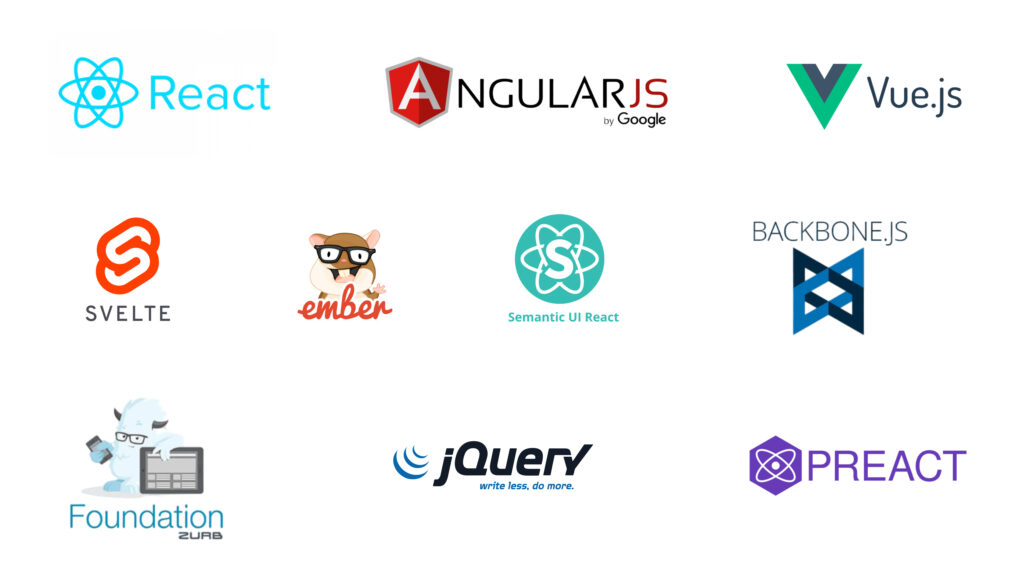
Top Frontend Frameworks For Web Development In 2023
In today’s market, user experience is of the utmost importance for any business. As a developer, the simplicity of the user interface is often a key focus of any project brief. Despite the complexity of the functions and operations happening behind the scenes, the end user’s experience must be smooth and seamless. This is a principle that many successful companies, such as Netflix, Facebook, and Instagram, have implemented in their designs.
However, as customer demands and the market continue to evolve, there is a constant need to improve the quality of usability and functionality. This can create challenges for developers, especially when selecting the best front-end javascript frameworks to meet these needs.
If you need help choosing the proper web UI framework for your project, consider contacting WTA Studio’s experts for guidance on selecting the best front-end development options to suit your requirements. In the following, we will highlight some of the top Frontend Frameworks for 2023, making it easier for those wondering which frameworks are currently popular.
Top Frontend Frameworks Of 2023

According to The State of JavaScript 2019, React, Angular, and Vue are the most popular Frontend Frameworks among developers, making them the top choices for 2023.
1. React
React, developed at Facebook to address code maintainability issues, is one of the most accessible learning frameworks. Now an open-source framework, React stands out due to its virtual Document Object Model (DOM), which offers exceptional functionality. It is an ideal framework for projects anticipating high traffic and requiring a stable platform to handle it.
As a technology consultant, React is recommended for projects that involve building single-page web applications and PWAs. Some of the benefits of using React include the following:
- The reusability of components makes it easy to collaborate and reuse in other parts of the application.
- Consistent and seamless performance with the use of virtual DOM
- The ability to write components in React hooks, allowing developers to learn React more easily
- Advanced and valuable React dev tools
However, there are also some challenges to using React, such as:
- Difficulty in making proper documentation due to multiple and constant updates in the framework, which can impact the learning curve for beginners
- JSX can be challenging for developers to understand when first starting with the framework
- React only provides frontend solutions
When deciding whether to use React for a project, it is essential to consider the team’s experience with Javascript and the project’s complexity. React is an excellent choice for building user interfaces, particularly single-page applications. Still, there may be better fits for inexperienced developers or projects with a steep learning curve.
2. Angular
Angular is a prominent framework that must be included in a list of the best frontend development frameworks. Uniquely based on TypeScript, Angular was officially launched by Google in 2016 to meet the increasing demands of technology while still utilizing conventional concepts.
One of the key features of Angular is its two-way data binding, which allows for real-time synchronization between the model and the view. Any changes made in the model are instantly reflected in the picture and vice versa. This feature makes Angular well-suited for building mobile or web apps and multi-page and progressive web apps. Companies such as BMW, Xbox, Forbes, and Blender have developed Angular applications.
While Angular offers a wide range of functionality, it can be more challenging to learn than React. A lot of documentation is available, but it can be complex and confusing to read. Some benefits of using Angular include:
- In-built functionality for updating changes made in the model to the view and vice versa
Reduced amount of code due to features such as two-way data binding being provided by default.
- Components are decoupled from dependencies by defining them as external elements.
- Components are reusable and easy to manage using dependency injection
- A large community for learning and support
However, there are also some challenges to using Angular, such as:
- The steeper learning curve because of the multiple ways to perform tasks
- Dynamic apps may perform poorly because of their complex structure and size, but code optimization and best practices can mitigate this.
When deciding whether to use Angular for a project, it is essential to consider the scope and complexity of the project, as well as the size and experience of the team. Angular is an excellent choice for enterprise-based and dynamic web apps but may not be the best fit for smaller projects or groups with limited experience.
3. Vuejs
Vuejs is a popular front-end framework known for its simplicity and straightforwardness. It excels at removing the complexities that developers may face with Angular. It is smaller and offers two significant advantages: a visual DOM and component-based structure, as well as 2-way binding. Vue can handle various tasks, from building web and mobile applications to advanced web applications. It is capable of handling both simple and dynamic processes with ease.
Market giants have yet to adopt Vuejs, but it continues to grow in popularity, with companies such as Alibaba, 9gag, Reuters, and Xiaomi using the framework. Despite fewer adopters from Silicon Valley, Vuejs continues to gain traction.
Some benefits of using Vuejs include the following:
- Extensive and detailed documentation
- The simple syntax makes it easy for programmers with a javascript background to start.
- Flexibility in designing app structure
- Typescript support
However, there are also some challenges to using Vuejs, such as:
- Lack of stability in components
- Relatively small community
- Language barriers with plugins and components (most plugins are written in Chinese)
When deciding whether to use Vuejs for a project, it is essential to consider the design structure and the support community available. Vuejs is an excellent choice for flexible design structures and developing large projects. However, there may be better fits for applications requiring durable components or projects where a strong support community is needed.
4. jQuery
jQuery, first introduced in 2006, is one of the earliest Frontend Frameworks. Despite its age, it continues to be relevant in today’s tech world due to its simplicity and ease of use and its ability to minimize the need to write extensive JavaScript codes.
Due to its long-standing existence, a sizeable jQuery community provides solutions. jQuery is primarily a library used to manipulate CSS and DOM and optimise a website’s functionality and interactivity. With the recent development of jQuery Mobile, the framework has expanded to include the ability to build mobile applications with its HTML5-based UI system. Additionally, jQuery is compatible with any browser.
Some benefits of using jQuery include the following:
- Flexibility in adding or removing elements in the DOM
- Simplified sending of HTTP requests
- Facilitation of dynamic content
However, there are also some limitations to using jQuery, such as:
- Comparatively slow performance
- Availability of advanced alternatives
- Obsolete APIs for the document object model
When deciding whether to use jQuery for a project, it is essential to consider the scale of the project and the need for advanced functionality. jQuery is an excellent choice for developing desktop-based JavaScript applications with simple and concise code. However, it may not be the best fit for large-scale applications or projects that require advanced features and reusable components.
5. Emberjs
Emberjs, developed in 2011, is a component-based framework that offers two-way data binding similar to Angular. It is designed to seamlessly handle the increasing demands of modern technologies and is well-suited for developing complex mobile and web applications.
One of the main drawbacks of Emberjs is its steep learning curve. The framework can be challenging to learn due to its rigid and conventional structure. Additionally, being relatively new and under-explored, the developer community needs to be more significant.
Some benefits of using Emberjs include:
- Well-organized structure
- Fastest framework among its contemporaries
- Two-way data binding
- Proper documentation
However, there are also some challenges to using Emberjs, such as:
- Smaller and less popular community
- Complex syntax and slow updates
- Steep learning curve
- Heavy framework for small applications
When deciding whether to use Emberjs for a project, it is essential to consider the project’s scale and the development team’s experience. Emberjs is an excellent choice for building modern, rich user interface applications like LinkedIn. It also stands as a complete frontend solution for large-scale projects because it provides ready configuration, good binding and custom properties to render the page as needed. However, there may be better fits for smaller development teams or projects requiring less complexity and user interface. The initial cost may also be higher with Emberjs.
6. Backbonejs
Backbonejs is a simple and easy-to-use framework that allows for the swift development of single-page applications. It is based on the MVC architecture, where the View allows for implementing component logic similar to a Controller. It can also run engines like underscore.js and Moustache and can be used with tools such as Thorax, Marionette, Chaplin, and Handlebars to enhance its functionality.
One of the critical benefits of Backbonejs is its compatibility with REST APIs, which allows for seamless synchronization between the frontend and backend. Additionally, it is one of the fastest JavaScript frameworks and is lightweight and easy to learn.
However, there are also some limitations to using Backbonejs, such as:
- Provides essential tools to create the app structure (the framework does not offer a readymade structure)
- Requires writing boilerplate code to communicate between the view and model
When deciding whether to use Backbonejs for a project, it is essential to consider the scale of the project and the need for advanced functionality. Backbonejs is an excellent choice for dynamic applications like Trello and is efficient in handling updates, maintaining the client, and synchronizing with the server. However, there may be better fits for projects that require a complete solution in one framework, as it provides minimalistic requirements compared to other MVC client-side frameworks.
7. Semantic-UI
Semantic-UI is a relatively new front-end framework quickly gaining popularity for its intuitive user interface and ease of use. Its natural language coding style makes it easy for beginners to understand and implement. Additionally, its integration with many 3rd party libraries streamlines the development process.
Some of the advantages are:
- Latest front-end framework
- Has built-in functionality
- Simple to use
- Offers a variety of UI components and responsive design
Some of the challenges are:
- Larger package size
- Not suitable for those without knowledge of javascript
- Requires proficiency in custom development
Semantic-UI is best for projects that prioritize a lightweight and sleek user interface. If your team lacks experience with javascript and the ability to customize the application, there may be better choices than Semantic-UI.
8. Foundation
Foundation is a front-end framework developed by Zurb for enterprise-level responsive and agile website development. It is designed for advanced developers and can be challenging for beginners. Foundation offers GPU acceleration for smooth animations, mobile rendering, and data-interchange attributes for different device loading. If you’re interested in using Foundation, working on independent projects is recommended to become familiar with the framework’s complexities. It’s been implemented by companies such as Mozilla, eBay, and Microsoft.
Some of the advantages are:
- Flexible grids
- Allows for creating visually stunning websites
- HTML5 form validation library
- Customizable user experience for different devices and media
Some of the challenges are:
- Difficult for beginners to learn
- Fewer community forums and support platforms
- Competitor frameworks like Twitter Bootstrap are more popular
If you’re looking for styled CSS components and an open-source and mobile-friendly front-end framework, Foundation is a great choice. Foundation may not be suitable for beginners or those looking to modify code, as it can be complex due to its customization capabilities.
9. Svelte
Svelte is the latest front-end framework that differs from others by handling work during a compile step instead of the browser, like React and Vue. It writes code to update the document object model in sync with the application’s state.
Some of the advantages are:
- Better reactivity
- Faster than other frameworks such as Angular or React
- Latest framework available
- Scalable and lightweight uses existing javascript libraries
Some of the challenges are:
- Small community
- Limited support and tooling
- Not yet popular
Svelte is best suited for small app projects and with a small team. It’s not recommended for complex projects because of the limited community and tooling. Svelte is not recommended for larger projects as it has a small community, little support, and a lack of tooling. Finding answers to questions or bugs that may arise during development can be challenging.
10. Preact
Preact is a JavaScript framework that provides a lightweight and faster alternative to React. With a compact size of only 3kB when gzipped, compared to React’s 45kB, Preact offers the same modern API and functionality. It is commonly used for application development as it renders quickly due to its small size and fast Virtual DOM library.
Preact is similar to and compatible with React, making it easy for developers to adopt without learning a new library from scratch. Its compatibility layer (preact-compat) also allows developers to use existing React packages and even the most complex React components with minimal adjustments. This can save time and resources, whether starting a new project or updating an existing one. Many popular websites, such as IKEA, Bing, Uber, and Etsy, use Preact.
Some of the advantages are:
- Reduces library code in bundles, resulting in faster load times for users
- Enables highly interactive apps and pages to load in under 5 seconds, making it an excellent fit for PWAs
- Portable and embeddable, making it a good option for building individual parts of an app without complex integration
- It has a powerful, dedicated CLI that helps create new projects quickly
- Works well with many libraries in the React ecosystem
Some of the challenges are:
- It has minor community support and is not maintained by a major tech company as Facebook does for React.
- It does not have synthetic event handling like React, which can cause performance and maintenance issues using React for development and Preact for production.
Preact’s small size makes it an excellent choice for building web components, small web widgets, landing pages, and PWAs that need to load and become interactive quickly. It’s also a good option for small projects, prototyping, and targeting users with slow internet. Preact may not be suitable for building heavy, complicated, or large-scale projects as it may require additional packages to add missing functionalities.
Conclusion
These are some of my recommendations for the best Frontend Frameworks based on my experience developing large-scale projects and MVPs. With so many options, deciding on the best technology can be challenging. Understanding each framework and having practical experience are essential before making a decision.
Manish Surapaneni
A Visionary & Expert in enhancing customer experience design, build solutions, modernize applications and leverage technology with Data Analytics to create real value.
Other articles

Manish Surapaneni
Stop Outsourcing Your Ethics, Tech Leaders
Setting up their own ethics committee is a step forward for tech companies, as they are the clear winners of

Manish Surapaneni
How To Beat The Tech Talent Squeeze In 2023: 6 Proven Strategies
In the current economic climate, with rising costs and increased job turnover, one of the biggest mistakes a company can

Manish Surapaneni
How Augmented Human Intelligence Can Enhance Our Lives With Machines
The advancement of technology has simplified our lives. It has also significantly increased our reliance on electronic devices. MIT Media